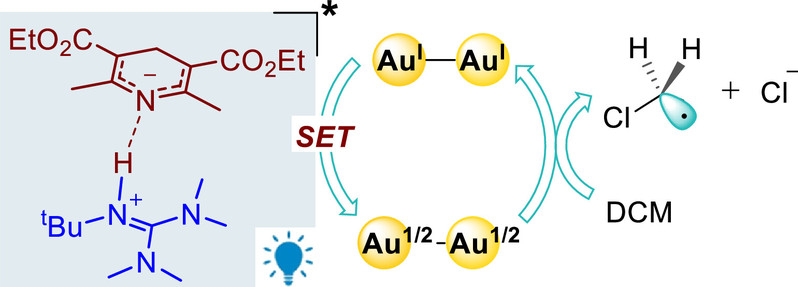Computational Insights into the Photoinduced Dimeric Gold-Catalyzed Divergent Dechloroalkylation of gem-Dichloroalkanes with Alkenes
Kaifeng Wang1, Xiaoguang Bao1,2*(鲍晓光)
1Innovation Center for Chemical Sciences,College of Chemistry, Chemical Engineering and MaterialsScience, Soochow University, Suzhou, Jiangsu 215123, China;
2Jiangsu Key Laboratory of Advanced Negative CarbonTechnologies, Soochow University, Suzhou, Jiangsu 215123,China
J. Am. Chem. Soc. 2024, 146, 11, 7679–7689
Abstract: The employment of dinuclear Au(I) catalysts in photomediated modern organic transformations has attracted significant attention over the past decade, which commonly demonstrates unique catalytic performance compared with the corresponding mononuclear gold complexes. Nevertheless, detailed mechanisms of dinuclear gold catalysis remain ambiguous, and further mechanistic understanding is highly desirable. Herein, computational studies were carried out to gain mechanistic insights into the photoinduced dinuclear gold-catalyzed divergent dechloroalkylation of gem-dichloroalkanes. Computational results suggest that a proton transfer from the additive, Hantzsch ester (HE), to the base, guanidine, could lead to an ionic pair complex, which is ready to undergo excitation under blue light irradiation to result in the corresponding triplet excited state. Then, the excited complex might undergo oxidative quenching with the dinuclear gold photocatalyst [AuI–AuI]2+, via a single-electron-transfer (SET) step to afford an unusual [Au1/2–Au1/2]+ dinuclear species. The corresponding mononuclear gold catalyst, [AuI]+, however, is not ready to enable the analogous step to give a [Au0] species, which might account for the unique characteristics of dinuclear gold catalysis. Subsequently, the formed [Au1/2–Au1/2]+ intermediate could trigger a Cl-atom transfer from dichloromethane in an inner-sphere manner to furnish a critical chloromethyl radical. Next, the resulting chloromethyl radical could attack the alkenyl moiety of substrates to generate the corresponding alkyl radicals. Then, three possible mechanistic pathways were explored to rationalize the substrate-dependent divergent transformations in this protocol. The main factors responsible for the diversified transformations were discussed.

链接://pubs.acs.org/doi/10.1021/jacs.3c14352